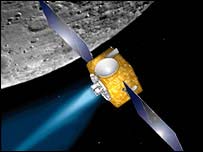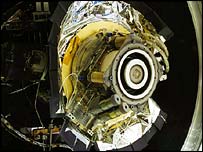SMART-1

ESA's SMART-1 approaching the Moon.

SMART-1's ion engine.
SMART-1 was the first spacecraft in the series of SMART (Small Missions for Advanced Research in Technology) probes to be launched by the European Space Agency. SMART is a program of small, relatively low-cost missions to test new technologies that will eventually be used on more ambitious projects.
SMART-1 was the first European spacecraft to travel to and orbit around the Moon. It was launched on 27 September 2003 from Kourou by an Ariane-5 Cyclade (along with two other satellites that formed the primary payload) and arrived in lunar orbit on 14 November 2004. However, the Moon was not so much the focus of the mission as the venue around which SMART-1 tested a solar-electric propulsion system like that employed by NASA's Deep Space 1. The same unit will be used by the Mercury probe BepiColombo.
Initially planned to operate six months around the Moon, SMART-1 was later given a mission extension of one further year. The spacecraft was deliberately crashed into the lunar surface on 3 September 2006.
SMART-1 experiments
EPDP and SPEDE. Designers of future solar-electric spacecraft want to know how SMART-1's ion engine performs, what side-effects it has, and whether the spacecraft interacts with natural electric and magnetic phenomena in the space around it. Possible problems include deflection of the ion engine's thrust direction, erosion of surfaces, short-circuits by sparks, interference with radio signals, and accumulating dust.
KaTE and RSIS. Small changes in SMART-1's motion revealed the precise thrust delivered by the ion engine. RSIS employed the Doppler effect, to see how the speed altered the wavelength of radio pulses. It used the very short radio waves of KaTE. The primary purpose of KaTE was to demonstrate the next generation of radio links between the Earth and far-flung spacecraft. Microwaves of the Ka band, around 9 mm in wavelength, can be focused into relatively narrow beams by the small dish antennas available on the spacecraft.
Laser Link is another communications experiment. ESA already has laser links with telecommunications satellites from an optical ground station on Tenerife in Spain's Canary Islands. Aiming the beam becomes much more difficult if, like SMART-1, the spacecraft is far away and moving rapidly. The hope was that the onboard camera AMIE would see Tenerife aglow with laser light.
OBAN. Future spacecraft will be more self-reliant in guiding themselves along pre-defined paths towards distant destinations. OBAN evaluated a computer technique for on-board autonomous navigation. It used the bearings of stars seen by SMART-1's star trackers, and Earth and the Moon seen by the AMIE camera.
AMIE, SIR and D-CIXS. Different kinds of visible and invisible light coming from the lunar surface provide clues about its chemical composition and geological history. The ultra-compact electronic camera, AMIE, surveyed the terrain in visible and near-infrared light. An infrared spectrometer, SIR, charted the Moon's minerals. An X-ray telescope, D-CIXS, identified key chemical elements in the lunar surface. One of the chief scientific goals of the mission was to search for water, in the form of ice bound up in the lunar rocks.
XSM. The D-CIXS measurements could be confused by variations in solar X-ray emissions, which depend on how stormy the Sun is at the time. So SMART-1 monitored the solar X-rays with its XSM instrument. XSM also made its own independent study of solar variability.
SPEDE. The Moon leaves a wake in the solar wind – the non-stop stream of charged particles and associated magnetic fields coming from the Sun. The SPEDE electrical experiment observed this effect at close quarters.
RSIS. With help from the KaTE microwave system and the AMIE camera, the RSIS radio experiment demonstrated a new way of gauging the rotations of planets and their moons. It was expected to be able to detect a well-known nodding of the Moon, which slightly tilts first its north pole and then its south pole towards the Earth.
Lunar impact
After 16 months in space, SMART-1 ended its mission by crashing onto the Moon's surface. At about 0542 GMT (0642 BST) on 3 September 2005, it came down on a volcanic plain called the Lake of Excellence with an impact speed of about 7,200 kilometers per hour (4,500 mph).


